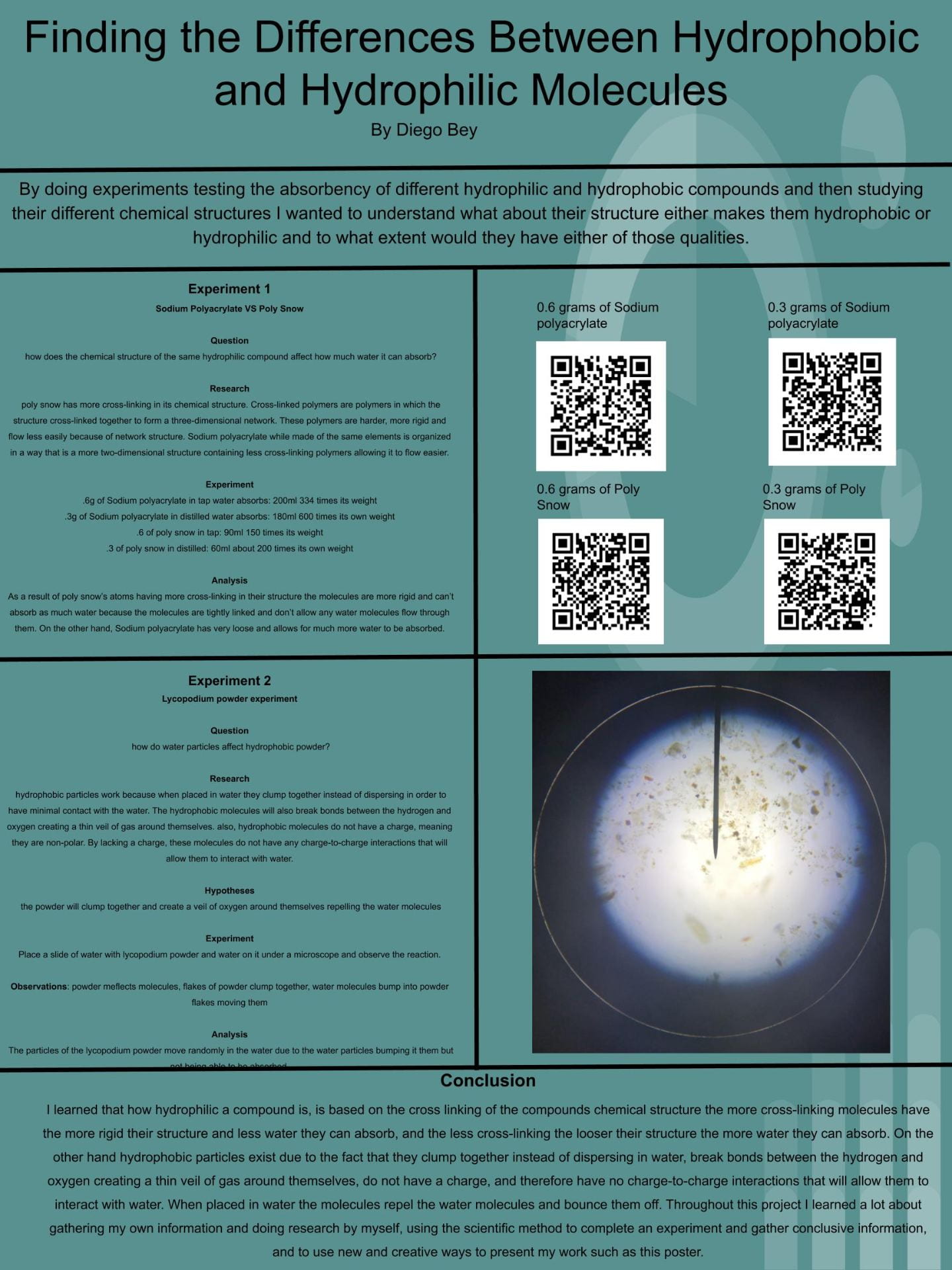Project by: Diego Bey (9th Grade)
Project Advisor: Kara Luce
Student(s)’s Advisor(s): Susan Now
Description of the Project:
By doing experiments testing the absorbency of different hydrophilic and hydrophobic compounds and then studying their different chemical structure I want to understand what about their structure either makes them hydrophobic or hydrophilic and to what extent will they have either of these qualities.
Final Product (e.g., documents, images, video, audio, poster, display, etc.):
Final Reflection on Learning:
Weeks 1-3: I found that while doing research for my experiments I learned the most about my subject and it was particularly powerful because I felt I was learning the most at the time. I found this to be a comfortable learning experience because it was all on my own, I did my own research, found my own sources, and collected my own information. I feel that I learned a lot about collecting my own information and paraphrasing it into the information I need. since I found this so effective I might try gathering extra information for my assignments on my own to try to replicate the experience.
Weeks 4-6: These weeks I found particularly fun because this was the week I completed the experiments. I was doing these experiments with Kara’s supervision but the experiments themselves I was doing alone. I think i enjoyed this so much because it was very visual, hands-on, and interactive so I got to really get into it and experience the reactions and effects instead of just reading about them. in future assignments, I will try more hands-on approaches to help me get a better understanding and enjoy the work more.
Weeks 7-9: I feel that the creation process of my poster shows growth in creativity with my process of organizing it, balancing the paragraphs with images and videos during this process I changed and redid it continually until I felt it was perfectly organized and easy to understand. in doing this I learned a lot about how to make a presentation that’s easy to understand and well organized.
Update on Progress from Weeks 1-3 (include any photos or video if relevant):
- completed outline and scientific method for each of the experiments
- Sodium polyacrylate VS poly snowQuestion: how does the chemical structure of the same hydrophilic compound affect how much water it can absorb?Research: poly snow has more cross-linking in its chemical structure. Cross-linked polymers are polymers in which the structure cross-linked together to form a three-dimensional network. These polymers are harder, more rigid and flow less easily because of network structure. Sodium polyacrylate while made of the same elements is organized in a way that is a more two-dimensional structure containing less cross-linking polymers allowing it to flow easier.Experiment:.63g of Sodium polyacrylate in tap water absorbs:.3g of Sodium polyacrylate in distilled water absorbs: .6g of poly snow in tapwater absorbs:
.3g of poly snow in distilled water absorbs:
Update on Progress from Weeks 4-6 (include any photos or video if relevant):
- completed both experiments
- Experiment: Poly Snow VS Sodium Polyacrylate.63g of Sodium polyacrylate in tap water absorbs: 200ml 334 times its weight.3g of Sodium polyacrylate in distilled water absorbs: 180ml 600 times its own weight.6 of poly snow in tap: 90ml 150 times its weight.3 of poly snow in distilled: 60ml about 200 times its own weight
- Experiment: effect of water on Lycopodium Powder (hydrophobic)
Place a slide of water with lycopodium powder and water on in under a microscope and observe the reaction
Observations:
- powder reflects molecules
- flakes of powder clump together
- water molecules bump into powder flakes moving them
Update on Progress from Weeks 7-9 (include any photos or video if relevant):
- finished up reflections on each meeting
- finished conclusions and analysis of data collected from experiments
- completed poster


Approved as grade level advisor.